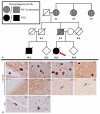A 6.4 Mb duplication of the α-synuclein locus causing frontotemporal dementia and Parkinsonism: phenotype-genotype correlations
- PMID: 25003242
- PMCID: PMC4362700
- DOI: 10.1001/jamaneurol.2014.994
A 6.4 Mb duplication of the α-synuclein locus causing frontotemporal dementia and Parkinsonism: phenotype-genotype correlations
Abstract
Importance: α-Synuclein (SNCA) locus duplications are associated with variable clinical features and reduced penetrance but the reasons underlying this variability are unknown.
Objectives: To report a novel family carrying a heterozygous 6.4 Mb duplication of the SNCA locus with an atypical clinical presentation strongly reminiscent of frontotemporal dementia and late-onset pallidopyramidal syndromes and study phenotype-genotype correlations in SNCA locus duplications.
Design, setting, and participants: We report the clinical and neuropathologic features of a family carrying a 6.4 Mb duplication of the SNCA locus. To identify candidate disease modifiers, we completed a genetic analysis of the family and conducted statistical analysis on previously published cases carrying SNCA locus duplications using regression modeling with robust standard errors to account for clustering at the family level.
Main outcomes and measures: We assessed whether length of the SNCA locus duplication influences disease penetrance and severity and whether extraduplication factors have a disease-modifying role.
Results: We identified a large 6.4 Mb duplication of the SNCA locus in this family. Neuropathological analysis showed extensive α-synuclein pathology with minimal phospho-tau pathology. Genetic analysis showed an increased burden of Parkinson disease-related risk factors and the disease-predisposing H1/H1 microtubule-associated protein tau haplotype. Statistical analysis of previously published cases suggested there is a trend toward increasing disease severity and disease penetrance with increasing duplication size. The corresponding odds ratios from the univariable analyses were 1.17 (95% CI, 0.81-1.68) and 1.34 (95% CI, 0.78-2.31), respectively. Sex was significantly associated with both disease risk and severity; men compared with women had increased disease risk and severity and the corresponding odds ratios from the univariable analyses were 8.36 (95% CI, 1.97-35.42) and 5.55 (95% CI, 1.39-22.22), respectively.
Conclusions and relevance: These findings further expand the phenotypic spectrum of SNCA locus duplications. Increased dosage of genes located within the duplicated region probably cannot increase disease risk and disease severity without the contribution of additional risk factors. Identification of disease modifiers accounting for the substantial phenotypic heterogeneity of patients with SNCA locus duplications could provide insight into molecular events involved in α-synuclein aggregation.
Figures


Similar articles
-
Phenotypic variation in a large Swedish pedigree due to SNCA duplication and triplication.Neurology. 2007 Mar 20;68(12):916-22. doi: 10.1212/01.wnl.0000254458.17630.c5. Epub 2007 Jan 24. Neurology. 2007. PMID: 17251522
-
Patients homozygous and heterozygous for SNCA duplication in a family with parkinsonism and dementia.Arch Neurol. 2008 Apr;65(4):514-9. doi: 10.1001/archneur.65.4.514. Arch Neurol. 2008. PMID: 18413475
-
Alpha-synuclein gene rearrangements in dominantly inherited parkinsonism: frequency, phenotype, and mechanisms.Arch Neurol. 2009 Jan;66(1):102-8. doi: 10.1001/archneurol.2008.555. Arch Neurol. 2009. PMID: 19139307
-
Autosomal dominant Parkinson's disease caused by SNCA duplications.Parkinsonism Relat Disord. 2016 Jan;22 Suppl 1(Suppl 1):S1-6. doi: 10.1016/j.parkreldis.2015.09.007. Epub 2015 Sep 3. Parkinsonism Relat Disord. 2016. PMID: 26350119 Free PMC article. Review.
-
α-Synuclein and Parkinsonism: Updates and Future Perspectives.Curr Neurol Neurosci Rep. 2017 Apr;17(4):31. doi: 10.1007/s11910-017-0737-y. Curr Neurol Neurosci Rep. 2017. PMID: 28324300 Review.
Cited by
-
Investigation of somatic CNVs in brains of synucleinopathy cases using targeted SNCA analysis and single cell sequencing.Acta Neuropathol Commun. 2019 Dec 23;7(1):219. doi: 10.1186/s40478-019-0873-5. Acta Neuropathol Commun. 2019. PMID: 31870437 Free PMC article.
-
SNCA Rep1 microsatellite length influences non-motor symptoms in early Parkinson's disease.Aging (Albany NY). 2020 Oct 20;12(20):20880-20887. doi: 10.18632/aging.104111. Epub 2020 Oct 20. Aging (Albany NY). 2020. PMID: 33082300 Free PMC article.
-
Profiling Non-motor Symptoms in Monogenic Parkinson's Disease.Front Aging Neurosci. 2020 Oct 30;12:591183. doi: 10.3389/fnagi.2020.591183. eCollection 2020. Front Aging Neurosci. 2020. PMID: 33192488 Free PMC article. Review.
-
From Synaptic Dysfunction to Neuroprotective Strategies in Genetic Parkinson's Disease: Lessons From LRRK2.Front Cell Neurosci. 2020 Jul 28;14:158. doi: 10.3389/fncel.2020.00158. eCollection 2020. Front Cell Neurosci. 2020. PMID: 32848606 Free PMC article. Review.
-
Copy number variability in Parkinson's disease: assembling the puzzle through a systems biology approach.Hum Genet. 2017 Jan;136(1):13-37. doi: 10.1007/s00439-016-1749-4. Epub 2016 Nov 28. Hum Genet. 2017. PMID: 27896429 Free PMC article. Review.
References
-
- Spillantini MG, Schmidt ML, Lee VM, Trojanowski JQ, Jakes R, Goedert M. Alpha-synuclein in Lewy bodies. Nature. 1997 Aug 28;388(6645):839–840. - PubMed
-
- Polymeropoulos MH, Lavedan C, Leroy E, et al. Mutation in the alpha-synuclein gene identified in families with Parkinson’s disease. Science. 1997 Jun 27;276(5321):2045–2047. - PubMed
-
- Singleton AB, Farrer M, Johnson J, et al. alpha-Synuclein locus triplication causes Parkinson’s disease. Science. 2003 Oct 31;302(5646):841. - PubMed
-
- Ibanez P, Bonnet AM, Debarges B, et al. Causal relation between alpha-synuclein gene duplication and familial Parkinson’s disease. Lancet. 2004 Sep 25;Oct 25;364(9440):1169–1171. - PubMed
Publication types
MeSH terms
Substances
Grants and funding
- K24 AG000949/AG/NIA NIH HHS/United States
- J-0804/PUK_/Parkinson's UK/United Kingdom
- ZO1 AG000949-08/AG/NIA NIH HHS/United States
- 089698/WT_/Wellcome Trust/United Kingdom
- Z01 AG000949/ImNIH/Intramural NIH HHS/United States
- MR/J004758/1/MRC_/Medical Research Council/United Kingdom
- WT_/Wellcome Trust/United Kingdom
- G0701075/MRC_/Medical Research Council/United Kingdom
- G0802760/MRC_/Medical Research Council/United Kingdom
- G1001253/MRC_/Medical Research Council/United Kingdom
- G108/638/MRC_/Medical Research Council/United Kingdom
- G-0907/PUK_/Parkinson's UK/United Kingdom
- G-1107/PUK_/Parkinson's UK/United Kingdom
- MC_G1000735/MRC_/Medical Research Council/United Kingdom
LinkOut - more resources
Full Text Sources
Other Literature Sources
Miscellaneous

